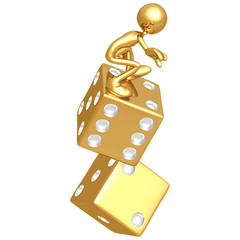 Edwin Schrodinger used a famous thought experiment to try and explain part of Quantum theory. The experiment placed a cat (now known as Schrodinger's Cat) in an unobservable place where after some time there was a 50/50 chance the cat would be either dead or alive. Quantum theory considers the cat to be in a state that is both 50% alive and 50% dead until an observer sees the results. At that time, the probability fields collapse and the cat is either alive (although quite annoyed) or has forever passed on.
Edwin Schrodinger used a famous thought experiment to try and explain part of Quantum theory. The experiment placed a cat (now known as Schrodinger's Cat) in an unobservable place where after some time there was a 50/50 chance the cat would be either dead or alive. Quantum theory considers the cat to be in a state that is both 50% alive and 50% dead until an observer sees the results. At that time, the probability fields collapse and the cat is either alive (although quite annoyed) or has forever passed on.This finally answers the ancient philosophical question if a tree falls in the woods and no one is around to hear does it make a sound? We now know that the answer is "probably".
The IRS has defined a term Fair Market Value in Revenue Ruling 59-60 as:
"... the amount at which property would change hands between a buyer and a willing seller when the former is not under and compulsion to buy and the later is not under any compulsion to sell, both parties have reasonable knowledge of the relevant facts."
Such a simple definition creates many probabilities. The least useful are a seller's hope of how much it could be worth and a buyer's hope of how little. There are 3 reality-based paths to approaching the problem:
1) Asset Approach - the replacement cost not considering earning power
2) Income Approach - a discounted estimate of future cash flows
3) Market Approach - comparisons of similar businesses which have sold in the past.
Each of these methods have multiple methodologies which all yield different results and all of them have their appropriate application for specific buyer and seller circumstances. It is the job of the evaluator to accurately assess values based on all of them and then create the combination of probabilities that best represent the scenario described in IRS 59-60. They have to value the state of Schrodinger's cat before the observation. It's a professional opinion that needs to be done by a CPA Accredited in Business Valuation (ABV) or a Certified Valuation Analyst (CVA).
A survey by Inc magazine concluded the 75% of privately held businesses listed for sale do not successfully change hands. The culprit is generally the price. The seller has one probably in mind and the buyer another and they cannot agree. A certified Fair Market Value creates a common anchor for both parties to use in coming to an agreement. Having this common anchor creates the quantum Probably Field that almost always leads to agreement and a successful business sale.
What has happened is the intense observations already done during the valuation pre-collapse the quantum probably fields to a region known to be acceptable to the seller and limiting to a buyer. It's interesting how the intricacies of sub-atomic particles mirror the intricacies of complex business transactions, yet it's all the same universe always acting in the same way.
Image Credit: skuds
![Reblog this post [with Zemanta]](http://img.zemanta.com/reblog_e.png?x-id=91a18e16-fac8-459e-b96a-b631449f0eac)

![Reblog this post [with Zemanta]](http://img.zemanta.com/reblog_e.png?x-id=226c3e33-2492-46ca-8529-d6a4a9a8b8a0)

![Reblog this post [with Zemanta]](http://img.zemanta.com/reblog_e.png?x-id=c744699c-0390-4242-b303-c722ae686b7e)

![Reblog this post [with Zemanta]](http://img.zemanta.com/reblog_e.png?x-id=071e2339-71ee-42b1-83b5-c2fc98efe4a9)

![Reblog this post [with Zemanta]](http://img.zemanta.com/reblog_e.png?x-id=66df53dd-9185-4514-8a77-73ea240ea2ec)